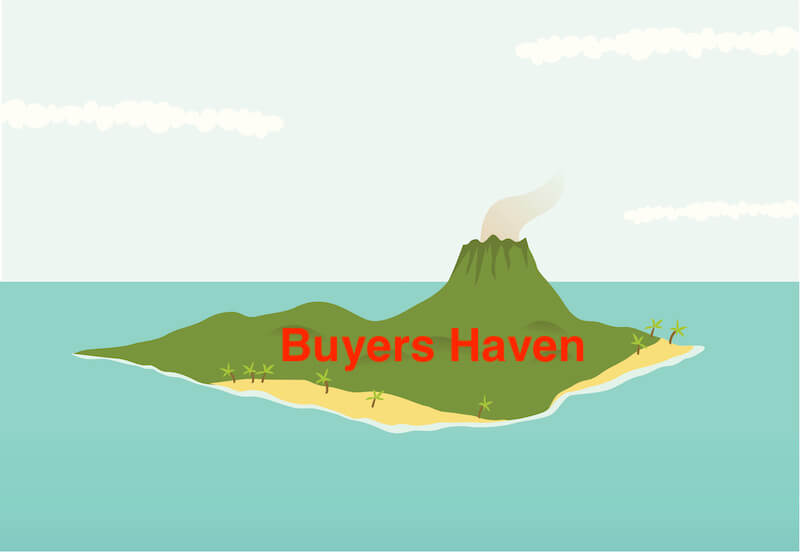Why is so much content marketing unsuccessful?
Unfortunately, so much of the brand content I see and study creates desert islands. That is, it isolates itself in one of two ways, which I call content marketing desert islands.
Imagine two real islands. Both are populated and within sight of each other. But they have no means of communication or trade between the two. So they remain isolated and are unable to benefit from each other.
Let’s look at the two content marketing islands: Brand Island and Prospect Island. Then we’ll dive into how to build a bridge between them that leads to content marketing success.
[Tweet “Most content marketing is unsuccessful because it’s stuck on one of two desert islands.”]
Brand Island

Brand Island is populated by the purpose, intention, and marketing of your company. It’s everything you built your business for in the first place.
The specifics of purpose/intention/marketing are as varied as the number of companies in existence, but all for-profit brands have one goal in common: acquiring and satisfying new customers. One of the ways they try to accomplish that goal is the creation and promotion of content.
But far too many content strategies never get off of Brand Island. Why is that?
Have we told you how awesome we are?
One approach that prevents inter-island bridge building is content that only talks about the brand itself. This content is all about the brand’s products, services, competitive advantages, etc. It does a good job of covering why your company is so great and what makes you stand out from the rest.
This kind of content is essential for prospects who are already shopping for what you offer and who have become aware of your brand. By all means your website should have very thorough, easily-accessed information about your products or services. Potential customers will want this information to help them in their buying decision.
However, brand-centered or product/service-centered content does little for you at the top of the funnel, where you first begin to attract prospects to your brand. It lacks a clear connection to the wants and needs of the prospect (see the next island below). This content is like a rude guest at a dinner party who barges into conversations to brag about all his accomplishments. Even if they are objectively interesting, you’re not likely to be receptive.
Prospect Island

Prospect Island is where your potential customers live. These are the people you want to attract and entice to come visit your Brand Island so they can consider what you have to offer.
If your content is only brand-centric, the inhabitants of Prospect Island may look across the channel and notice signs of life on your island, but they have no reason to want to cross the water gap.
Allow me to extend my metaphor a little further. Imagine that your brand content is an ambassador from Brand Island who boats over to Prospect Island to propose the building of a bridge between the two archipelagos. Your ambassador gives a flashy presentation about all the great points of interest on Brand Island. However, it is obvious he knows or cares little about the actual hopes, needs, and aspirations of the Prospect Islanders. So the mutual bride project is rejected.
Watch me pull a rabbit out of my hat!
In the age of content marketing, and especially its promotion via social media, many brands are aware that in order to connect with the citizens of Prospect Island they need to attract their attention and get their engagement. However, overemphasizing those needs can lead to the error of prospect-centric content, which can be just as ineffective as brand-centric content.
Overly prospect-centric content focuses on attention and/or engagement for their own sakes. Recognizing that both are hard to get from busy consumers, this content sacrifices brand goals and message to get attention by being overly cute, entertaining, or controversial.
Sometimes such content is successful in gaining attention and engagement, but it ultimately fails to make a clear connection with your brand.
An expensive example of prospect-centric content failure is Super Bowl ads. Brands found that an entertaining or controversial ad during America’s most-watched sporting event can create tremendous “buzz.” Media will cover it and consumers will share it.
But post-game consumer surveys show these ads score low in effectiveness (brand recognition and/or fulfillment of desired action).
If we look at the key criteria or drivers of ad effectiveness, below shows that, while Super Bowl ads do very well on “likeability” and generating “buzz”, these didn’t fare so well on key action points and particularly on such critical measures as “purchase intent.”
In striving to provoke a reaction for reaction’s sake, the ads failed to make a memorable connection between the brand and the consumer’s needs and desires. Many consumers had vivid memories of the content of the ads, but could not recall what it was actually promoting.
It’s vital for content to gain attention and keep viewers engaged, but if that’s all it does, it is not effective content marketing.
The Content Marketing Bridge

Effective content marketing builds a bridge between Brand and Prospect Islands. More specifically, it connects with the real needs, hopes, and wants of prospects without losing the brand mention.
Building bridge content involves three steps. All three must be pursued intentionally for the content to succeed.
- Know your brand goals. It never ceases to amaze me how many brand marketers cannot clearly articulate exactly why their company exists and what it does. If you don’t want to lose a connection to your brand that will lead prospects to explore further, you must first accurately define what your brand is about, and what differentiates you from your competition.
- Know your prospects. In my experience this is the step most neglected by content marketers. We tend to assume that we know what our prospects need and want, but those assumptions are often wrong (or miss important aspects). Do your homework to answer these questions:
- What about us attracted people who became our customers?
- What holes in their lives or businesses did our products or services fill, and why?
- What emotions or desires underlay positive actions taken by our customers?
- Find the links. This is the most difficult step, but also the most critical. Once you’ve done the tasks above, begin to think about the aspects of your brand and its products or services that link with the needs, hopes, and wants of your prospects. Then create content that speaks to the latter while associating it with the former.
[Tweet “Content marketing must build a bridge between your brand goals and prospects’ needs.”]
Hit the triggers
The most successful brand content not only tags all three bases listed above, but it scores the run by making an emotional connection. As noted above, in an age of content overload you must grab attention and keep it, and you must engage the audience. The trick is to do that without sacrificing your message.
You do that by creating stories that speak to your audience’s best emotions, but also make a strong metaphorical connection to your brand message.
Learn more!
For some examples of highly successful content that built an effective bridge while hitting the necessary emotional triggers, see my Marketing Land post Three Brands Still Killing It on Facebook. More on content marketing:
PRO TIP! A great place to hone your content marketing bridge-building skills is by creating brand Facebook Groups. These groups often get great engagement of a type Facebook hungers for, so they get a strong push in user newsfeeds. Here’s an excellent guide to best practices for brand Groups.

Thank you so much for sharing your knowledge and experience. It is especially invaluable to those like me who are just starting out. Right now I’m working mostly on my website and have two dormant blogs, which because you’ve given me the tools, I can see the possibilities and the light for all three.